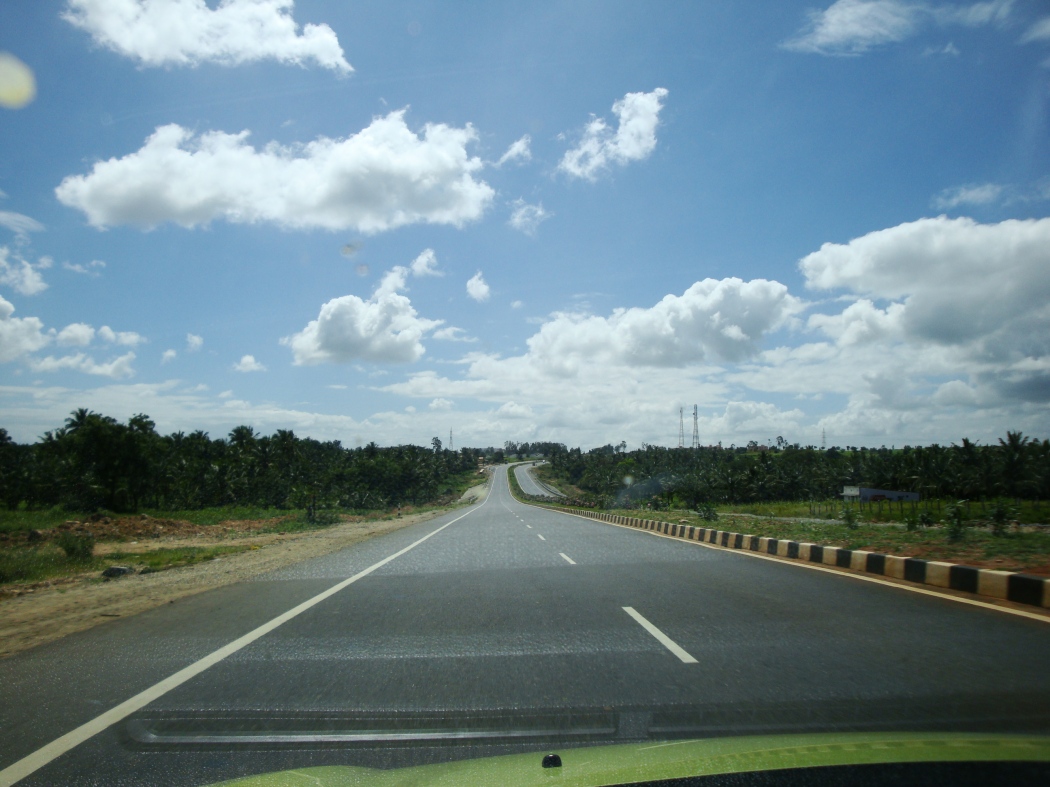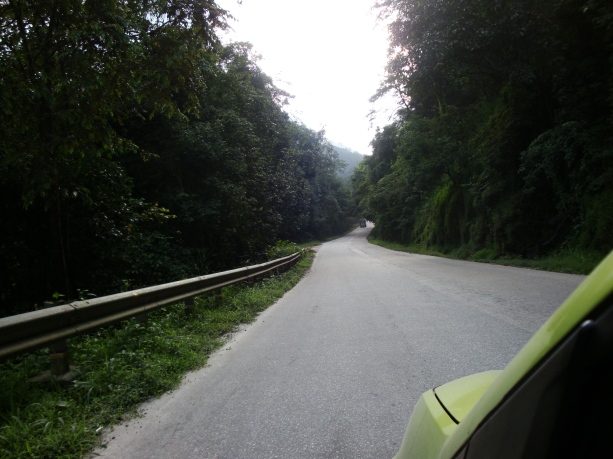I decided to document our road trip to Dharmasthala and Malpe instead of continuing with our trip to Coorg from the first part here because it was an adventurous road trip and just right to write for the BlogAdda travel blogging activity. I am chronicling this road trip adventure for CEAT Tyres in association with BlogAdda.
Back in September 2014, when my research paper got accepted for presentation in a conference at an engineering college in Dharmasthala, I and D decided to make a trip out of it and included the nearby Malpe beach into our itinerary. We love beaches and a visit to any of the Karnataka beaches was pending in our list. So we started out after breakfast hoping to reach Dharmasthala by late afternoon. We decided to go by this route.

It was to be our second trip through Western Ghats area, the first one being the trip to Ooty. The drive on NH75 was so smooth and awesome. It was a clear blue sky day and a bit hot. It was hard trying to stay within 100 kmph on the great quality of road with less traffic.

NH75
Soon the highway changed from four lane to two lane which was also good. As we neared Sakleshpur, the road condition began to deteriorate and it was hard to believe that it was a national highway!! We stopped for lunch at Kamath Upachar on

Two lane national highway

Road condition getting bad
After sometime from Hassan, we could make out from the vegetation that the Shiradi Ghat area had started.

The Ghat road was quite wide and the traffic consisted of trucks and cars. But soon the smooth drive ended and the stretch of the National Highway passing through the Shiradi Ghat got very bad. We were going slow anyway due to Ghat region but now we had to drive slower to avoid getting back ache and to prevent damage to car suspension!! Concrete and asphalt were missing altogether!! It was one of the worst roads we have driven on till date. Thank god for CEAT Tyres that we made it through without any mishap.

We had to stop to take a picture of the road!!

Horrible road!!
Nevertheless the drive through the Ghat region was mesmerizing with the different varieties of trees surrounding the road, the blue hills in the horizon and a bubbling stream hidden somewhere in the forest cover, sometimes getting louder, sometimes farther. I was not looking forward to meeting any elephants in the area. We had hoped to reach by late afternoon but due to slow speed, evening had started to set in. I was praying that we make it out of the forest before dark. There was no mobile signal also for a major portion of the road. Apart from that, it was one of its kind of drive. The late afternoon sun looked so beautiful through the canopy of trees.

Sun playing hide and seek

Heading into the unknown!

Hills in the horizon
At last we could catch sight of the elusive stream..rather a river!! Google informed me later that it was the Kempuhole river which originates from the Sahyadris.

Kempuhole River
The road condition became better and soon we turned right onto SH37 which leads straight to Dharmasthala.

Out of Ghat area at last!
Sun had already set by the time we reached the guesthouse where the college authorities had made accommodation arrangements for our stay. We were exhausted by the unplanned long drive. We checked in, had dinner at the canteen of the guesthouse and went to bed.
The next day D went exploring the town while I was away attending the conference. The town, located in the Dakshina Kannada district, is famous for its Dharmasthala Temple which houses the shrine of Shiva, Manjunatha, Ammanavaru, Chandranath and the Dharma Daivas (guardian spirits of Dharma) namely Kalarahu, Kalarkayi, Kumaraswamy and Kanyakumari. (Source:Wikipedia) Apparently, on an average the flow of pilgrims is about 10,000 people a day!! But since neither D nor I were interested in visiting the temple, I won’t be able to provide any information on that in this blog. D loved the natural surroundings of the place though.

The Gateway to Dharmasthala

Sri Manjunatha Temple
I spent the next day also in conference while D watched movies on laptop in the guesthouse as there is nothing much to do in the small secluded town..infact not even a good place to eat. The guesthouse canteen was pathetic in variety of dishes. Then on the 3rd day, after breakfast we moved on to our next destination – Malpe. The road condition was good. We decided to go to Malpe through Mangalore though it is the longest route.

We stopped at the NIT Surathkal beach on our way. The weather was bit hot but it was so refreshing to see the Arabian Sea. The beach was clean and deserted at that time of day except for a couple or two of lovebirds 🙂 There was a lighthouse at the beach giving a mystical look to the beach. As the tide was low there were some moss-covered stones exposed which were accessible but not to be climbed barefooted!! We spent some time playing in the water and photographing the views. Then the tide started to increase which forced us and reminded us that we have still not reached our destination.
We had planned to stay only one night at Malpe and we had booked our room at Paradise Isle Beach Resort which located right on the Malpe Beach. When we reached the hotel, we were thrilled to see the location. The room/cottage was also good. The surroundings and the garden were well-kept.
After we freshened up, we went for lunch. Even after two years I still remember what we had ordered because it was so delicious!! Being on seashore means seafood for me and so I ordered Crab Masala while D ordered Chicken Hariyali along with rice and roti. Both the dishes were awesome in taste!! The only other time I have eaten such tasty crab dish was when we had visited Puri.
After such a splendid lunch an afternoon siesta was a must. Then we went off to the beach in evening. Malpe is a natural port located about 6 km from Udupi, Karnataka. It is an important fishing harbor too. The beach had golden brown and whitish colored sand which gave it a different look. Beach gazebos, palm trees, less crowd and cleanliness made the beach even more attractive, especially the gazebos which gave the beach a unique look. The water was also quite clean and blue. A melee of activities was going on at the beach. Young boys were flying kites which are made & sold by locals at the beach. Some guys were going on jet ski rides, some were driving ATVs on the beach, some kids were enjoying camel rides, some enjoying the water and some people like me were lazing about on the beach. There is something enchanting in watching the waves come and go..I could spend hours doing that..just chatting with a companion and looking at the ocean/sea.

Gazebos at the beach

Kai Po Che!

Sand Sculpture
The different stages of sunset at Malpe beach



We came back to our hotel after darkness fell. We decided to have vegetarian dinner and that turned out to be horribly tasteless!! Sadly the place doesn’t have much eating options outside. Then at night we sat at the porch chatting while listening to the night sounds of the sea until mosquitoes made it impossible to do so!!
Next day before checking out, we again went to the beach. Malpe beach has many islands off the coast, among which St.Mary’s Islands – a set of four small islands – is the most famous tourist destination. They are known for their unique geological formation of basalt rocks but sadly, due to lack of time, we couldn’t visit that place.


The golden brown colored sand
Then our drive back home began. We left after breakfast. As we were going to drive from Malpe to Bengaluru, it was going to be a long drive. In the entire Ghat stretch of road, there are just small eateries. We stopped at one to have tea and to stretch our legs. Then in Sakleshpur, we stopped at a restaurant called Surabhi’s Nx for a late lunch. The food was okay. The view behind the restaurant was very good. By that time dark clouds had begun to gather making the weather awesome.
Soon it started raining and that slowed down the drive speed to avoid any skidding. But again thanks to our car’s CEAT tyres, we didn’t face any problem.
Thus one of our work + fun road trips ended with lovely memories and a promise to go back again to visit St. Mary’s Islands next time.



























































